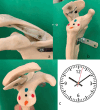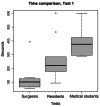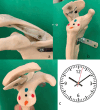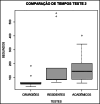Construct Validity and Experience of Using a Low-cost Arthroscopic Shoulder Surgery Simulator
- PMID: 37908521
- PMCID: PMC10615612
- DOI: 10.1055/s-0043-1771003
Construct Validity and Experience of Using a Low-cost Arthroscopic Shoulder Surgery Simulator
Abstract
Objective To validate the low-cost model for arthroscopy training and analyze the acceptance and usefulness of the developed simulator in medical teaching and training. Method Ten medical students, ten third-year orthopedic residents, and ten shoulder surgeons performed predetermined tasks on a shoulder simulator twice. The parameters used were time to complete the tasks, number of looks at the hands, GOALS score (Global Operative Assessment of Laparoscopic Skills) and comparison between groups and within groups. An adapted Likert scale was applied addressing the individuals' impressions about the simulator and its applicability. Results In the intergroup comparison, the shoulder surgeons had better scores and times than the other groups. When the tasks were repeated, the group of surgeons had a 59% improvement in time (p < 0.05), as did the group of medical students. In the GOALS score, shoulder surgeons had consistently better scores than the other groups. And when we evaluated the evolution from the first to the second test, the group of surgeons and the group of academics had a statistically significant improvement (p < 0.05). In terms of lookdowns, there was a decrease in all groups. There was consensus that the simulator is useful in training. Conclusion The simulator developed allowed the differentiation between individuals with different levels of training in arthroscopic surgery. It was accepted by 100% of the participants as a useful tool in arthroscopic shoulder surgical training.
Keywords: arthroscopy; shoulder; simulation training; training technique.
Sociedade Brasileira de Ortopedia e Traumatologia. This is an open access article published by Thieme under the terms of the Creative Commons Attribution-NonDerivative-NonCommercial License, permitting copying and reproduction so long as the original work is given appropriate credit. Contents may not be used for commercial purposes, or adapted, remixed, transformed or built upon. ( https://creativecommons.org/licenses/by-nc-nd/4.0/ ).
Conflict of interest statement
Conflito de Interesses Os autores declaram não haver conflito de interesses.
Figures










Similar articles
-
Construct Validity and Experience of Using a Low-cost Arthroscopic Knee Surgery Simulator.J Surg Educ. 2021 Jan-Feb;78(1):292-301. doi: 10.1016/j.jsurg.2020.06.007. Epub 2020 Jun 24. J Surg Educ. 2021. PMID: 32591322
-
Construct Validity, Assessment of the Learning Curve, and Experience of Using a Low-Cost Arthroscopic Surgical Simulator.J Surg Educ. 2017 Jan-Feb;74(1):47-54. doi: 10.1016/j.jsurg.2016.07.006. Epub 2016 Oct 5. J Surg Educ. 2017. PMID: 27720405
-
Shoulder Arthroscopy Simulator Training Improves Surgical Procedure Performance: A Controlled Laboratory Study.Orthop J Sports Med. 2021 May 10;9(5):23259671211003873. doi: 10.1177/23259671211003873. eCollection 2021 May. Orthop J Sports Med. 2021. PMID: 33997080 Free PMC article.
-
Simulation Training Improves Surgical Proficiency and Safety During Diagnostic Shoulder Arthroscopy Performed by Residents.Orthopedics. 2016 May 1;39(3):e479-85. doi: 10.3928/01477447-20160427-02. Epub 2016 May 2. Orthopedics. 2016. PMID: 27135460 Clinical Trial.
-
Efficacy of standardized training on a virtual reality simulator to advance knee and shoulder arthroscopic motor skills.BMC Musculoskelet Disord. 2018 May 16;19(1):150. doi: 10.1186/s12891-018-2072-0. BMC Musculoskelet Disord. 2018. PMID: 29769058 Free PMC article.
Cited by
-
Early introduction of simulation in the medical curriculum: the MedInTo perspective.Front Med (Lausanne). 2024 Jan 4;10:1280592. doi: 10.3389/fmed.2023.1280592. eCollection 2023. Front Med (Lausanne). 2024. PMID: 38239607 Free PMC article.
-
Evolution and trends in the management of acromioclavicular joint dislocations: an epidemiological analysis from Germany between 2013 and 2023.JSES Int. 2025 Apr 1;9(4):1040-1047. doi: 10.1016/j.jseint.2025.03.005. eCollection 2025 Jul. JSES Int. 2025. PMID: 40703419 Free PMC article.
References
-
- Bridges M, Diamond D L. The financial impact of teaching surgical residents in the operating room. Am J Surg. 1999;177(01):28–32. - PubMed
-
- Scott D J, Bergen P C, Rege R V et al.Laparoscopic training on bench models: better and more cost effective than operating room experience? J Am Coll Surg. 2000;191(03):272–283. - PubMed
-
- Canbeyli İD, Çırpar M, Oktaş B, Keskinkılıç Sİ. Comparison of bench-top simulation versus traditional training models in diagnostic arthroscopic skills training. Eklem Hastalik Cerrahisi. 2018;29(03):130–138. - PubMed
LinkOut - more resources
Full Text Sources

